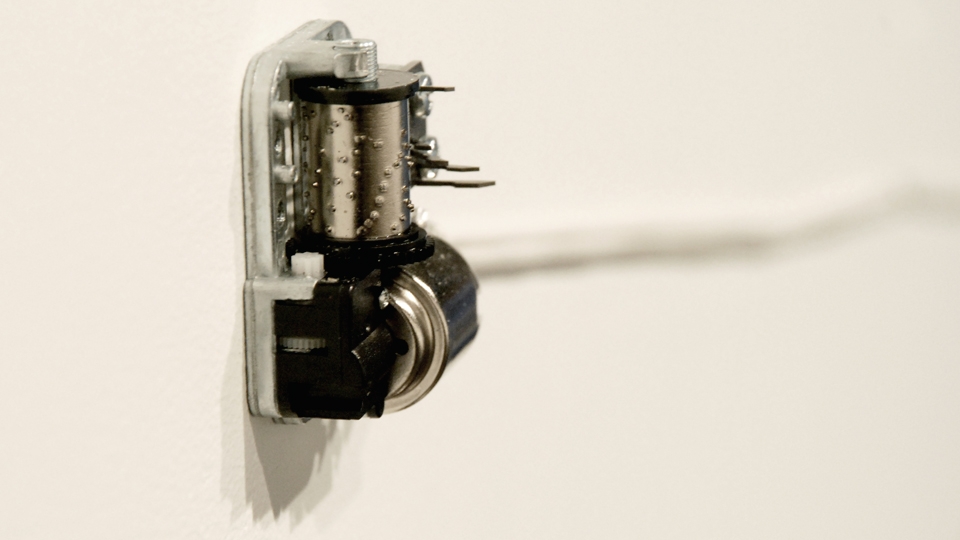Photo: Ethan Rose. Movement. Music boxes and electronics. 2008.
“Rose-colored Sound” by Lisa Radon
Originally published June, 2011
Armonica, music box, pipe organ, player piano. Sound artist and composer Ethan Rose, employs antiquated music making technologies to make hauntingly beautiful experimental music in his installation pieces. Yes, these sound-making devices are activated and synchronized with modern electronic technology, but it is behind the scenes. “Movements,” at Ambach & Rice in Seattle and at PICA’s TBA:10 Festival was a white room whose walls were studded with the exposed inner-workings of music boxes. Rose had manipulated them, by bending back some of their tiny tines, and connected them to an electronic controller to sequence their movements. The composition they played was spare and lovely, aimless but hopeful in the way that music box music is. But there was something else, a whir and clicking of the motion of the little machine behind the music.
Rose aimed to explore or similarly expose the technology of the kinds of sonic effects that are commonly used in digital music production in “Between Rooms and Voices,” his composition for the Flash Choir, performed in the central atrium of Portland’s City Hall. Rose composes film soundtracks and had been in the studio quite a bit when he began thinking about “Between Rooms.” Rose says, “I was interested in considerations around space, and the translation of electronic- and studio-based technologies into physically realized experience and performance. I had been playing with sound, how to transform/change sound, and one of the biggest way to do that is through spatial effects which are based on real phenomena. Echo, reverb, and a fade out where dragging down the fader on the mixing board is equivalent to someone walking away from you as they are singing or playing.” So members of the choir moved around and through the audience and throughout the space which has at its core two open staircases and is surrounded by mezzanines. “I thought of that piece as a way to reposition those spatial effects in the real world, revealing that transformation, lifting a curtain off, offering an awareness of space transforming the sound.”
In a flipside of that experience, Portland had its first listen to Rose’s 2009 project, “Oaks,” as we, the audience, moved through the space…hundreds of us on roller-skates at a PICA-sponsored event at Oaks Park Roller Rink. For the hauntingly beautiful album of the same name, Rose had sourced all of the sounds from Oaks Park’s 1920s era Theater Organ that was originally in Portland’s Broadway Theater.
In collaboration with Damien Gilley, Rose explored sound-making in space in another way for “APPROXIMATE” an exhibition curated by TILT Export: for galleryHOMELAND. Here, Rose recorded the sounds of the building, a former Ford motorcar plant, created a composition, and played it back through overhead speakers.
Perhaps his most memorable installation was another collaboration with glass artist Andy Paiko. “Transference” at the Museum of Contemporary Craft was a beautiful instance of the visual and the sonic in perfect complement in an elegant re-visioning of the glass armonica. Paiko blew 40 clear glass bowls that the two worked together to tune, but only slightly. For the most part, Rose let the bowls make the sounds they wanted to make when “played” as a small felt pad was pressed on each of their rims as they spun, installed on the walls. (This works the way you “play” the rim of a wine glass with your finger.) Rose coordinated hidden controls that determined when each of the spinning bowls would be played. As a result, the resonant tones ebbed and flowed in the space, creating an ambient chorus.
“We didn’t completely let the material completely just be what it was, but almost,” Rose says. “That interactive compositional strategy is a very important and exciting way to work with materials and objects. It’s similar to working with music boxes with their predetermined set of notes.”
Ethan Rose’s music is featured in films by Urszula Antoniak, Ryan Jeffery, Chel White and Gus Van Sant. Most recently the second film he has scored by director Urszula Antoniak, Code Blue, premiered at Cannes in May.
Rose is currently pursuing an MFA in the sound department at the Art Institute of Chicago, the only visual art school in the country with a sound program. “It is giving me the opportunity to delve into installation work I’ve been doing as well as opening up the potential for critical dialogue, and offering exposure to means, to tools,” Rose says. Rose plans an installation for winter in both Portland and Chicago. “Getting at methods to figure out ideas I’ve been working on is a big part of why I’m here.”
Courtesy of The Oregon Arts Commission.
Artist Credit: Ethan Rose, PICA.
